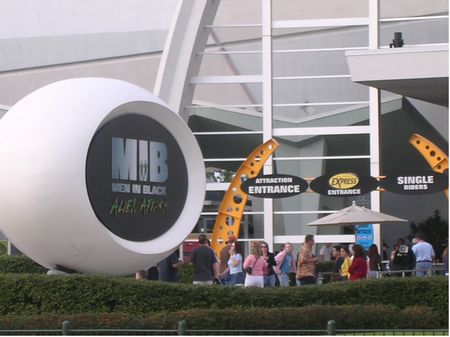(Which is one way of saying, 'Yeah, he quoted me, but I got more to say.')
Theme parks have been reaching out to the video game generation for a decade now. Shoot-'em-ups like Men in Black and Buzz Lightyear have become theme park staples. Disney's light-up pins and Pal Mickey have flirted with extending interactive technology outside the attraction gates. And SeaWorld's long been the master at interactive experiences, with its various animal encounters. (For a hefty extra charge, of course.)
But those represent just the first steps toward truly interactive theme park experiences. It's all Web 1.0 - the way the Internet was "interactive" around 1998 or so. You click on whatever you want and get different experiences all day.
The real power of interactivity emerges when it doesn't simply allow guests to interact with the park (or website publisher), it comes when the guests can interact with each other. That's Web 2.0 - and what Theme Park Interactivity 2.0 needs to become.
Think about what really hard-core MIB fans do when they come down the line. They chat up the folks in the line around them, asking how many times they've ridden, what's their high score, etc. If they're not sharp, let 'em cut ahead. But if they're good, keep 'em, and put together a car that's sure to win the suit, beating the car on the other side.

What happens when parks find a way to formalize that cooperation within a theme park adventure? How cool would a Harry Potter attraction be if you had to sort into teams (houses?) to complete a mission - and the winners were rewarded with getting to stay for the next mission without having to wait in the queue again? (Think pick-up basketball here: Losers walk and winners play the next team.)
Interactivity raises the addictiveness of theme park attractions, like airtime and high scores first did in years past. An attraction that visitors will want to ride again and again not only continues to drive attendance long after its initial season (making it a better capital investment for the park), it relieves the pressure on the park to develop more expensive attractions, shops and restaurants to occupy guests after that initial ride, doubling the value of the investment.
Theme park managers and designers read this website. What would you like to see from them? What interactive experiences would you love to see in a dream attraction?
Tweet
Video games, however, are one of the exceptions to this rule. They do buy video games. Lots of them. Maybe it's because they do not feel they are being ripped off by video games. A song, movie, or show always provides the same experience, but a video game can be experienced again and again and never be the same.
On an entirely different note, I feel that the future of attractions will be Dark Rides, some of which will make Spiderman look like a Ferris Wheel ride 15 years from now. When my future children say "Dad, Spiderman was cool back then?" and groan at me, that's when I'll know that the attractions have gone to the next generation.
Harry Potter's dark ride may be the litmus test. If Harry Potter doesn't surpass Spiderman (having been built a good 10 years later), it probably says a lot about how incredible and ahead of its' time Spidey was and still is.
Accessibility ought to be a must, too. Ideally, it would enable a more level "playing field" than people with various disabilities would encounter typically in everyday life.
In a nutshell : randomness is better than elitism at the Parks.
This article has been archived and is no longer accepting comments.
I'd love to have an array of videogame "home versions" of attractions that interface (somehow) with their full scale, three dimensional in-park analogues (again: think Buzz Lightyear Astro Blasters as a template, albeit one that has barely scratched the surface of its potential).
How about an online gaming experience visit to The Haunted Mansion or Pirates or Spidey that ALSO somehow gives you preview peeks of people actually experiencing those attractions?
Promotional gold mine, there -- and I'm speaking as a guest who (in 2006) visited California instead of Florida for the perks of collecting a then-current set of Disneyland's VMK trading cards that interfaced with the online experience (I already had Walt Disney World cards, and that sealed the West Coast deal for me). AND I met up with a friend from Canada who did the same thing for the same reason.
Sure -- my friend & I are grownups, and we ribbed one another about being SO motivated by a videogame that it actually affected our real life behavior/vacation plans... but as much as we laughed it up it's still true.
More internet/in-park crossovers, please! :)